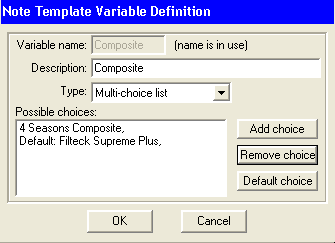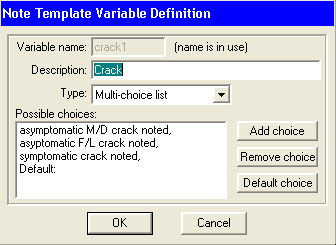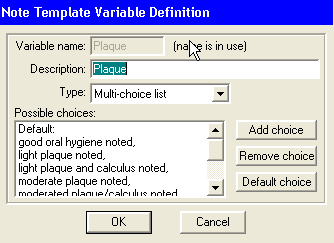Tutorial: This restoration note is primarily written for composite fillings because in our practice we don’t get very many people wanting silver/mercury fillings (not that there is anything wrong with them). Having a custom note makes charting easy, efficient, and most importantly, accurate. Being able to write a quick chart note gives you more time to spend with your patient, which is a win-win for our dental team and our community.
The code for this note is as follows:
<Consent> <HlthHx> Restoration was performed with <Rubber Dam> <biteBlock> <H2O2> <Dycal> <Etch> <DDS> <LPOP> <geristore> <Flowable> <Composite> <Comp Shade> <Comp Shade> <Comp Shade> <ClassVI> <reason> <reason> <gingivectomy> <laser1> <PulpCap> <Deep> <Conservative> <crack1> <underP> <lateralForce> <tolerated> <diffAccess> <gag> <Plaque> <bleeding2> <OHI> <noAnesth> Topical anesthetic <Topical> with <AnesNumMg> of <Anesthetic> <AnesthFil> <AnesthBlock> <AnesthMental> <AnesthPulp> <AnesthLig> <AnesthAkin><CompuDent> <addAnesth> <AnesNumMg> <Anesthetic> <AnesthFil> <AnesthBlock> <AnesthMental> <AnesthPulp> <AnesthLig> <AnesthAkin><CompuDent> Pt informed not to eat food, bite or chew on lips or tongue while anesthetic is still working. <OraVerse> <Next Visit><secNV><secNV><secNV>
And will look like this when it is completed:
Informed Consent, Reviewed health history, Restoration was performed with Rubber Dam, bite block used, Hydrogen Peroxide, Dycal, Acid Etch, DDS, PQ1, Flowable Composite, Filteck Supreme Plus, Dentin Shade A3.5, Composite Shade A2, Enamel Effect White, Broken Filling, Recurrent Decay, gingivectomy to access decay, diode laser with eye protection, indirect pulp cap, Deep decay, asymptomatic M/D crack noted, under partial rest/clasp, adjusted lateral occlusal forces, Treatment was tolerated well. difficult access, gagger, moderate plaque noted, bleeding controlled, Oral Hygiene Instructions, Topical anesthetic 20% lido/4% Tetra/2% phenylephrine with 1 carpule (54mg/1.7ml) of 3% mepivacaine plain mandibular nerve block, with CompuDent. additional anesthetic used 1 carpule (68mg/1.7ml) 4% Articaine w/1:100000 epi infiltration, with CompuDent. Pt informed not to eat food, bite or chew on lips or tongue while anesthetic is still working. OraVerse 0.8mg. Next Visit: Cleaning/Comp Exam/FMX, Filling(s), Endo, Post/crown
This note is so involved that it could not be screen shot in one picture.
Notice the first eight variables are “Check box” variables. They are pretty straight forward to make. Just press the “Define new” button and select from the pull down menu “Check Box”. I called the “Grouping” category “Filling” but you can call it “Restorations” if you would like and the “Summary” field I called “Fillings”.
I made a “Multi-choice list” for my bonding agents because I use more than one type for different procedures and just wanted one variable for them all.
We are in a transition between two different composite materials so a “Multi-choice list” variable was made with the default setting on the newest composite.
Now comes the next big “Multi-choice list” variable called “Composite Shade”. Be sure and list your shades in a logical pattern. Remember no mistakes or you will have to delete everything up to and including the mistake and redo it correctly. We use the Vita shades along with all the dentin and enamel variations. We even include all the modifiers.
Of course, more shades are listed in this <Comp Shade> variable than can be seen with this screen shot.
Next big “Multi-choice list” variable is the reason why this filling is done in the first place. This is an often over looked but critical part of any complete charting note. The list of reasons I have in my variable are as follows: Decay, recurrent decay, broken filling, broken tooth, repair old filling, repair crown margin, repair endo access, abfraction lesion, leached out dentin. You can add other reasons that you can think of to this list.
Sometimes I can see cracks in the floor of the cavity preparations and I think it is a good idea to make a note of them for future reference.
Noting the patient’s general plaque index is always a good idea. This will help you explain recurrent decay at some future appointment.
Then to finish up this filling note just add onto the end of this note the entire note that you made for anesthesia by cutting and pasting it and you are done!
For you hard tissue laser doctors, you guys are so smart I feel confident you can figure out how to add variables to cover that.
For you amalgam guys, just make a “Check box” variable and call it “amalgam,” and place it somewhere around the composite.
Now you can fill out the most complete filling note ever made in a dental chart in less than 60 seconds.









